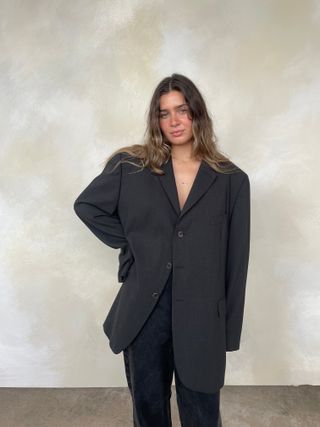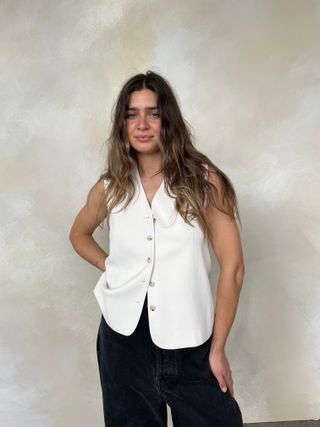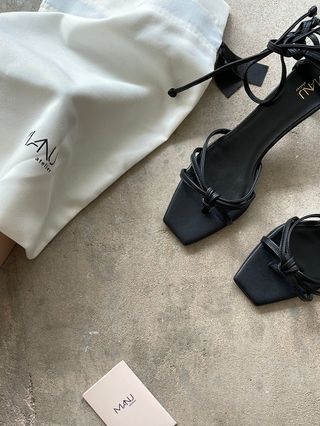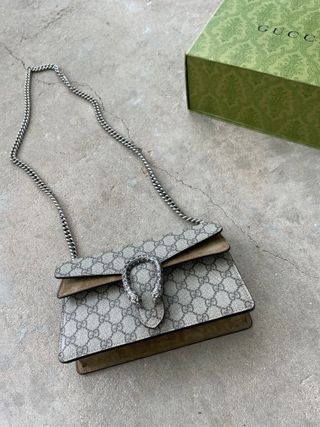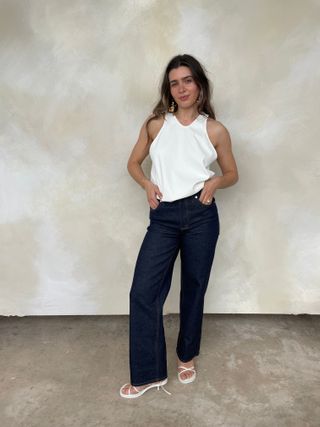Everything You Need to Know About Shopping and Selling Pre-Loved Fashion.

If there is one thing we’re passionate about at Who What Wear UK, it’s smart, considered shopping. And whilst we always pride ourselves on buying less and buying better with a view that every item we purchase, whatever the price, should be seen as an investment in our wardrobes, it’s a fact that there will always be room for improvement. One area of fashion that can still be intimidating for some—yes, even editors—is the world of pre-loved clothing.
In 2024, it’s never been easier to shop pre-loved. With the boom of Vinted, Depop, Vestiaire Collective and eBay, to name but a few, it’s safe to say that the world is well and truly opening its eyes to the importance—and joy—of slowing down the fashion cycle. Many well-established brands and e-tailers are also introducing pre-loved edits into their mix. It’s all fantastic progress, but it also means that finding the perfect pre-loved piece can be overwhelming. Where do you begin when it comes to searching for an item? What materials are a big no-no? How do you work out if an item is authentic? Is that price really worth it? And don’t even get me started on how to sell pre-loved fashion.
Thankfully, there are experts out there who can answer these questions and more, like Melanie Milham, founder of Curate & Rotate, an incredibly chic online resale destination based in Brighton that focuses on showcasing unique and independent brands on a range of women with different looks and body types. From the start, Curate & Rotate has had a unique perspective in the busy pre-loved marketplace. Milham prioritises high-quality materials, and her well-trained eye generates concise edits of minimal-leaning pieces that transcend seasons or years.
So, as we look to a new season (summer IS coming, people!), we thought there was no better time to ask Melanie to share her journey with us, along with her tips for shopping and selling pre-loved. Scroll on to discover what she had to say and find out more about the world of pre-loved fashion.
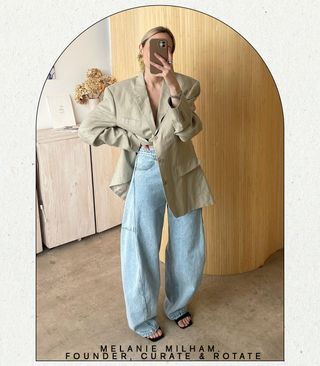
Tell us about your journey to Curate & Rotate. How did the business come about?
“Wow, it has been a very unexpected journey. Curate & Rotate started as a hobby whilst I was on maternity leave from my previous job in 2020. I had unloved clothing to sell, so I started an Instagram page to sell those items that had been sitting unworn in the back of my wardrobe for quite a while. This was just before pre-loved fashion was super popular, and I had absolutely no expectations that it would ever become a business; never in a million years did I think it would take off. It was just a passion project that I worked on, alongside caring for my then-baby.
“Somehow, the IG page started to grow and grow, and in 2021 I quit my regular job to turn Curate & Rotate into a fully-fledged business. I was so nervous at the time but I have not looked back since. I was a corporate PA, so what I do now and what I did for my job before are worlds apart. It has been such a dream to be able to explore my creative side! I had worked all my life, and when it came to having a year off on maternity leave, even though I was obviously super occupied with my baby, I missed working in some way, so Curate was born.
“I used most of my daughter’s nap time to work on my newfound hobby. I have no idea how I did it, but I guess when you feel you are working on something exciting and you have such passion, you just get through. I was tired but happy, bringing up my daughter and working on something I absolutely loved (and of course, still have so much love for). Curate & Rotate is my second baby. The business was built organically and I have never paid for any form of PR or marketing; I got here from hard work and determination. I won’t lie—it has not been easy, and in fact, it has been the hardest thing I have ever done in my life. I still feel I have so far to go, but I love what I do and I believe in the business. I am excited for the future and what will come next. Also, I think it’s worth mentioning that I had no previous fashion experience.”
What makes C&R different from other sites?
“We are very, very curated. We are selective with the pieces we sell, and only take on pieces we feel our customers will love. We also have a niche, as we focus on the resale of independent, contemporary and emerging brands. We favour clothes that are designed well and made to last, and we love neutral tones, although we do include a pop of colour sometimes! All of the clothing is modelled on our in-house models, and we also use women of the Curate community (our customers) to model for us. We love meeting our community and it’s so fun to have them come and visit us at our studio, wear our pre-loved pieces and showcase how fabulous they look on our socials and website.
“We think it is important to show how clothing looks on a body, and we love to show how each piece can be styled. Another unique part of Curate & Rotate is that we repair and restore our curated clothing if it needs some TLC, with the help of our seamstress, Frances. She plays a huge role in Curate & Rotate and has been with us since day one. We think it is important to bring worn pieces back to life and in the best condition possible for resale.”
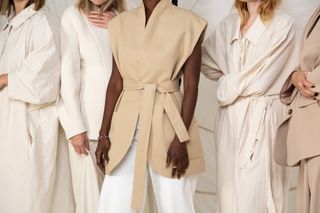
How do you decide what products make it to the site?
“We curate every single piece and choose them based on how much we feel they suit our brand, but we also ask ourselves if the C&R customer will love the item. We curate with our customer in mind, and it helps that we are our own customer; both myself and Elle, who works with me, shop at C&R. We have a list of our best-selling brands, but we are totally open to emerging labels, as long as the piece fits our style and is made to last. Ultimately, we love finding pieces a new home.”
How do you source the items?
“We source our stock through individual consignment customers looking to sell unloved pieces from their wardrobes, through brands by selling their past season and sample pieces, and I myself love to source clothing. Last year, I took trips to Paris and New York to hunt for pieces in secondhand and thrift stores. Next month, I am heading to Montreal and Toronto to see what gems I can find. We always love to hear from individuals and brands who need help finding new homes for their unloved items—we love collaborating with brands, it’s so special. We work with brands such as Mother of Pearl and E.L.V Denim.”
What do you look for when sourcing?
“We look for great quality, well-made, timeless pieces in great condition. We love pieces that will have longevity in our customers’ wardrobes.”
Our seamstress, Frances, plays a huge role in Curate & Rotate and she has been with us since day one. We think it is important to bring worn pieces back to life and in the best condition possible for resale.
What pieces and brands are really popular right now?
“Some of our customers’ favourite brands are Raey, Tibi, Lauren Manoogian, Toteme and Baserange. And for spring/summer, Australian brands always sell well. Brands such as Posse and SIR. get it right with effortless and easy-wearing linen pieces that can be worn year after year. Our customers also adore timeless, minimalist vintage pieces. Our reworked vintage pieces are selling well, we have been sourcing men’s vintage blazers and suits and reworking them with help from our seamstress.
“For instance, we are taking blazers and turning them into cropped jackets, adding popper fastenings so the blazers can be cinched in at the waist. Most recently, we have been turning men’s suit trousers into skirts that pair perfectly with the matching jacket. Our customers love unique pieces, and we enjoy creating them.”
Are there any colours, fabrics or finishes that are particularly popular?
“We are huge fans of neutral colours, and so are our customers. Whites, creams, beiges, camel, brown, black—although we do love a pop of colour every now and again, especially in spring and summer. Our customers love natural fabrics, and some of the most popular and sought-after are cotton, linen, cashmere, wool, silk and raw silk. These fabrics look good and feel good!”
Is there anything you’d never sell on-site?
“No fast fashion! We don’t think fast-fashion pieces have longevity.”
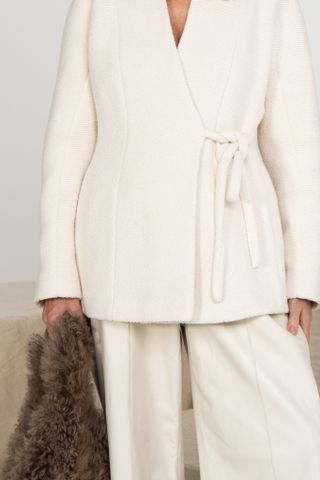
(Image credit: @CURATEANDROTATE / Amber Tanc, Betty Maguire)
It is also important that we support ethical fashion brands creating new, great-quality items of clothing, otherwise, we will not have those pieces to pass on and resell in the future. They need our support too. It’s all about mixing pre-loved and new together—it’s about balance!
What are the benefits of shopping for pre-loved fashion, both for individuals and the environment?
“There are huge benefits for both. Giving clothing that is already in circulation a new life is always a great thing. Individuals can find pre-loved pieces for a great price, and these pieces are kept out of landfills, so it’s a win-win. I do however think that it is also important that we support ethical fashion brands creating new, great-quality items of clothing, otherwise, we will not have those pieces to pass on and resell in the future. They need our support too. It’s all about mixing pre-loved and new together—it’s about balance!”
What are some common misconceptions about pre-loved fashion, and how do you address them?
“That pre-loved means awful quality and that the pieces aren’t stylish. I think you only need to look at our website and socials to see that this isn’t true. At Curate & Rotate, we are really showing people that pre-loved can be a brilliant option. Our items are of excellent quality, showcased beautifully on our models and are packaged like a new item would be.”
Can you share a memorable experience or success story related to your work in pre-loved fashion?
“That I built Curate & Rotate from scratch whilst on maternity leave with absolutely no experience, and getting it to where it is now. Also, any kind of press for Curate & Rotate brings me so much joy, like being featured in The Sunday Times Style. Amy Powney, creative director of Mother of Pearl, was asked to choose women who she thinks are changing the future of fashion for a special photoshoot and article. Never, ever did I think I would be featured in a magazine I read and love, especially not being called a ‘resale expert’! Life is crazy and sometimes I feel like I am dreaming.”
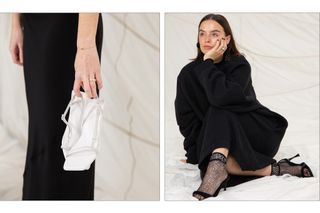
(Image credit: @CURATEANDROTATE / Amber Tanc, Betty Maguire)
1. Think about whether you need the item in your wardrobe or if you are buying it just because it seems like a bargain.
2. Use a local tailor to repair, restore and alter items. If you find something secondhand that needs some TLC or alterations, take it to your local tailor. Make clothes work better for you by altering them to fit your body. I am always buying trousers I love and having the waist taken in or the hems taken up.
3. Look at the material labels—this is so important! One of the first things I do when sourcing clothing is to look at the label to see the fabric composition. Get to know your fabrics and how to care for them and learn about the characteristics of fabrics. There is not one item of clothing I pick up that I haven’t looked at the inner label to find out more about it.
4. See clothing as an investment. If you buy well-made pieces, they will hold a considerable amount of their value if you care for them well. This is great if or when you want to sell that item. Save for items that are more expensive and you know will have longevity, one excellent piece is much better than 10 poor-quality items that won’t last. Look for those timeless pieces that you will get lots of wear from and build those up—pieces that can be dressed up or down.
5. Try to follow the one-in, one-out rule. I totally understand we can’t always be super strict with this, but it is a rule I try to follow. For every new item I bring into my wardrobe, another must leave and be sold. This way, my wardrobe doesn’t get too big. I am very strict now and am always waving goodbye to pieces to allow new items to take their place.
6. Ask for measurements of items to measure up against pieces you already have. Ask the seller or pre-loved business if they accept returns. This is great to know in case the item doesn’t fit you.
7. Find those curated pre-loved businesses that carry your personal style—it is easier to shop a curated selection.






